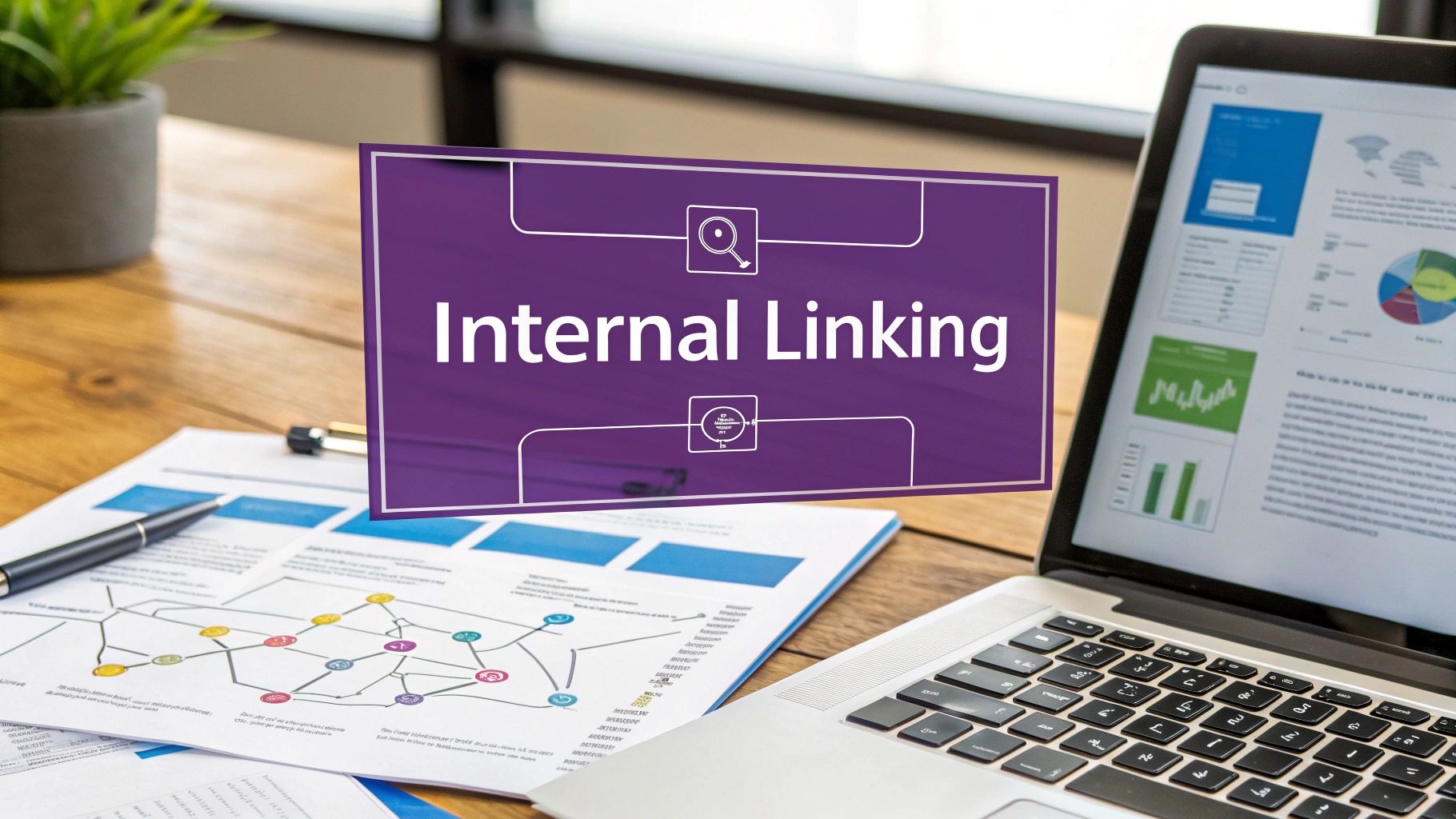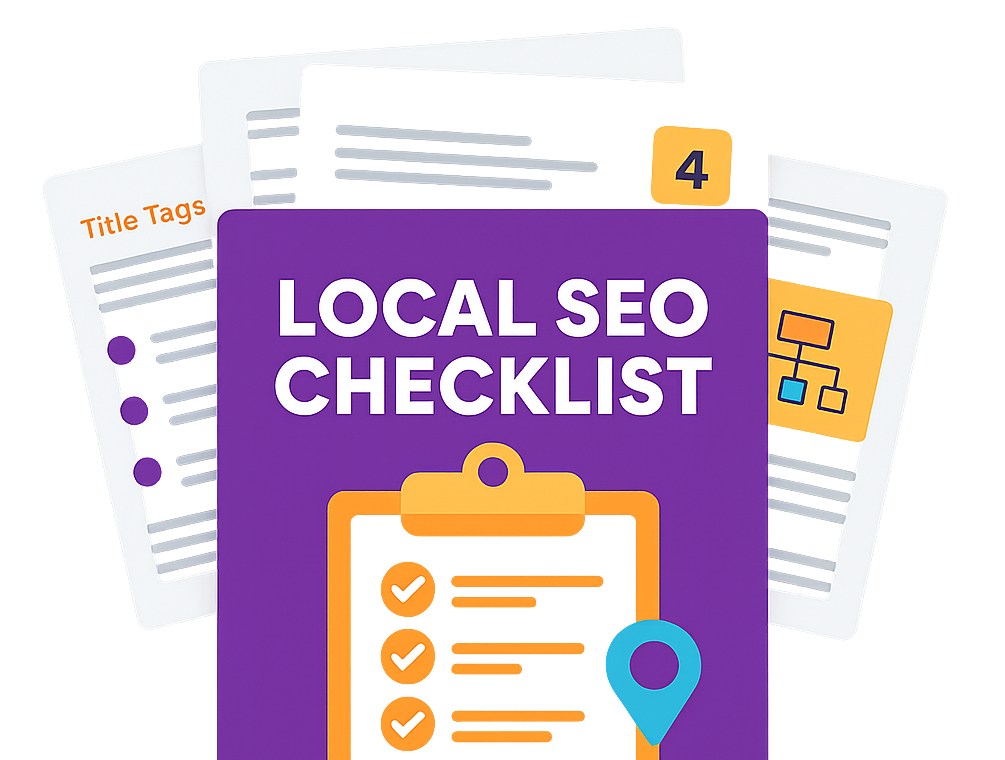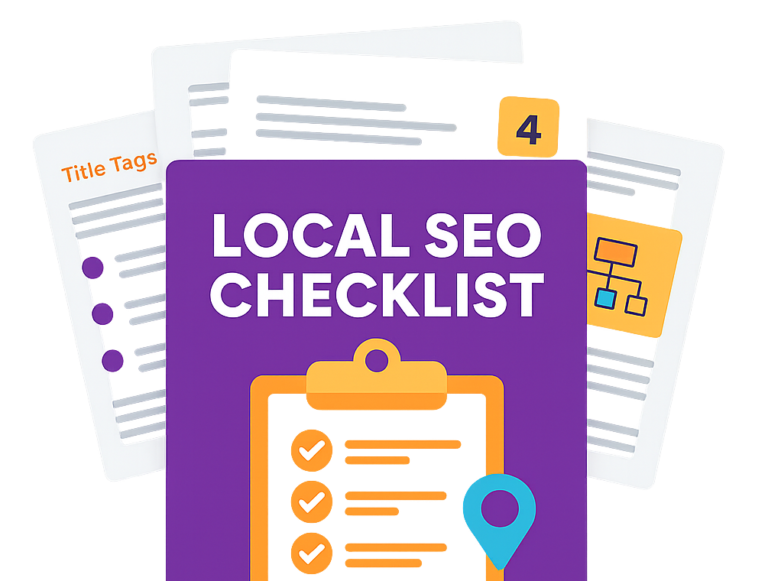When we talk about search engine optimisation (SEO), backlinks from other websites often steal the limelight. While they are undeniably crucial, many businesses overlook an equally powerful, and entirely controllable, factor: their internal linking strategy. A well-organised internal linking structure acts as the central nervous system of your website, guiding both users and search engine crawlers to your most important content.
It clarifies relationships between pages, distributes authority, and significantly enhances user experience. Understanding how these connections contribute to SEO is crucial for anyone looking to improve overall website ranking and site authority. Neglecting this fundamental aspect is like building a library with no signs or catalogue; the books are there, but nobody can find them efficiently. This guide moves beyond the basics to deliver actionable internal linking best practices you can implement immediately.
We will unpack eight specific strategies, from creating a logical site hierarchy and fixing orphan pages to performing regular audits. By the end, you'll have a clear framework for building a stronger, more visible, and better-performing website, helping you to realise your full SEO potential without relying solely on external factors. Let's get started.
1. Use Descriptive Anchor Text
One of the most fundamental internal linking best practices is using descriptive, keyword-rich anchor text. This is the clickable text in a hyperlink. Its purpose is to give both users and search engine crawlers clear, contextual information about the content of the destination page before they even click.
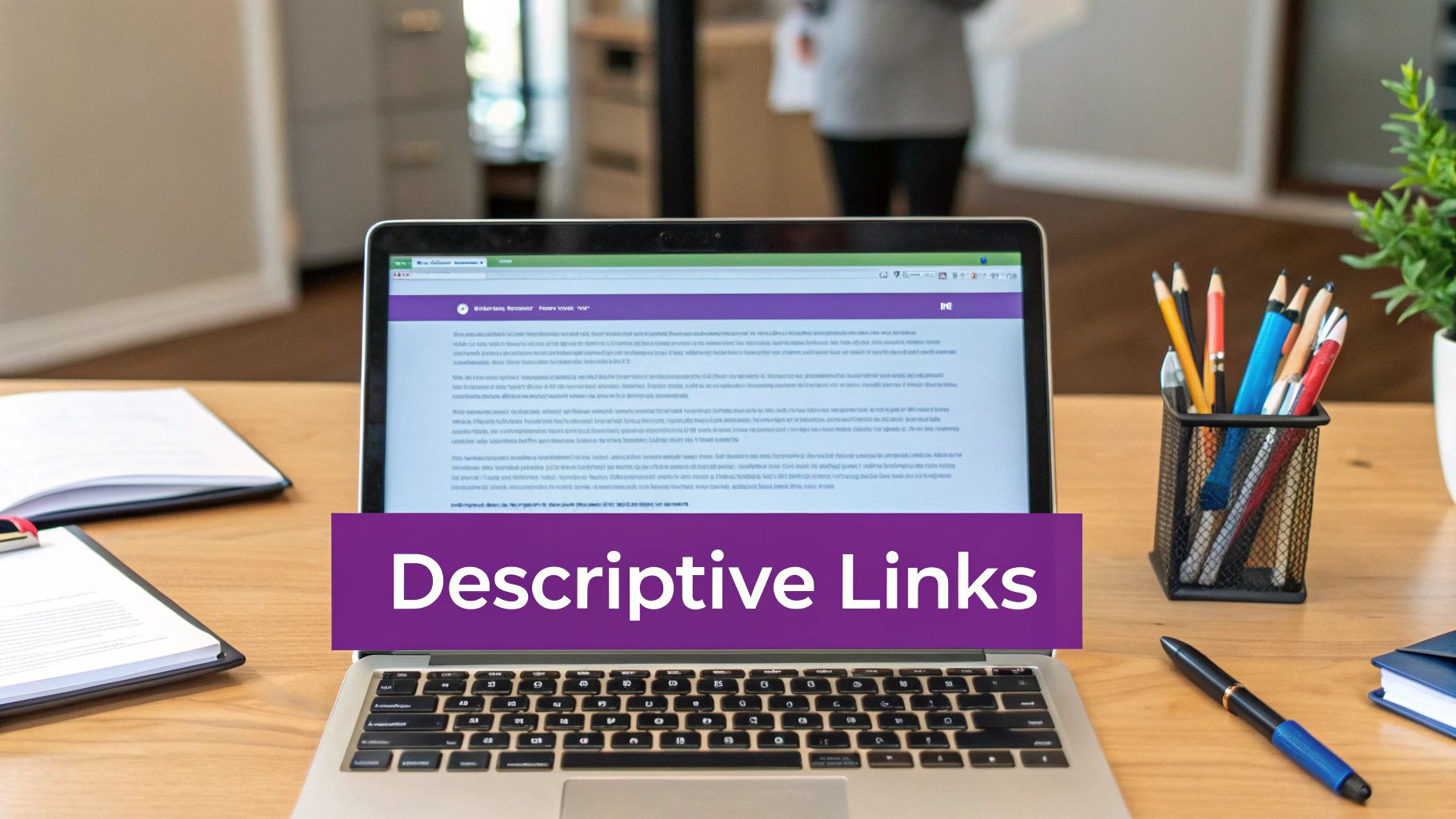
Generic phrases like "click here" or "read more" offer zero SEO value and a poor user experience. They don't inform search engines what the linked page is about, diluting the potential ranking signals you could be passing. In contrast, a well-chosen anchor like "beginners guide to keyword research" immediately signals relevance and authority for that topic. This practice helps distribute "link equity" or "link juice" more effectively across your site, signalling to Google which pages are important for specific queries.
How to Implement Descriptive Anchor Text
Successful implementation involves being specific and natural. For example, the health website Healthline excels at this by linking medical terms like "atrial fibrillation" directly to detailed articles explaining the condition. This creates a seamless, informative journey for the user. Similarly, when building internal links, you should aim to connect concepts logically.
Key Insight: Your anchor text is a direct signal to search engines about the topic of the linked page. Using descriptive anchors is like giving Google a clear roadmap of your site's most important content.
Actionable Tips for Anchor Text Optimisation
- Avoid Generic Phrases: Never use vague anchors like 'this page' or 'learn more'. Be specific.
- Vary Your Keywords: Instead of using the exact same anchor text every time, use semantic variations and long-tail keywords to appear natural.
- Match Anchor to Content: Ensure the anchor text accurately reflects the H1 title or main topic of the destination page. For instance, the anchor should align with the core message, much like optimising your URLs for SEO helps clarify page content. You can learn more about how to optimise URLs for SEO rankings on bare-digital.com.
- Keep It Concise: The anchor should be brief yet descriptive, fitting naturally into the flow of the sentence.
2. Create a Logical Site Hierarchy
A well-organised site structure is the backbone of any successful internal linking strategy. This involves arranging your website in a logical, pyramid-style hierarchy with the homepage at the top, followed by main categories, subcategories, and finally, individual content pages or articles. The primary goal is to ensure that no important page is more than three to four clicks away from the homepage, creating clear pathways for both users and search engines.
This infographic illustrates a clear, hierarchical site structure, showing how pages should be organised from the homepage down to individual content pages.
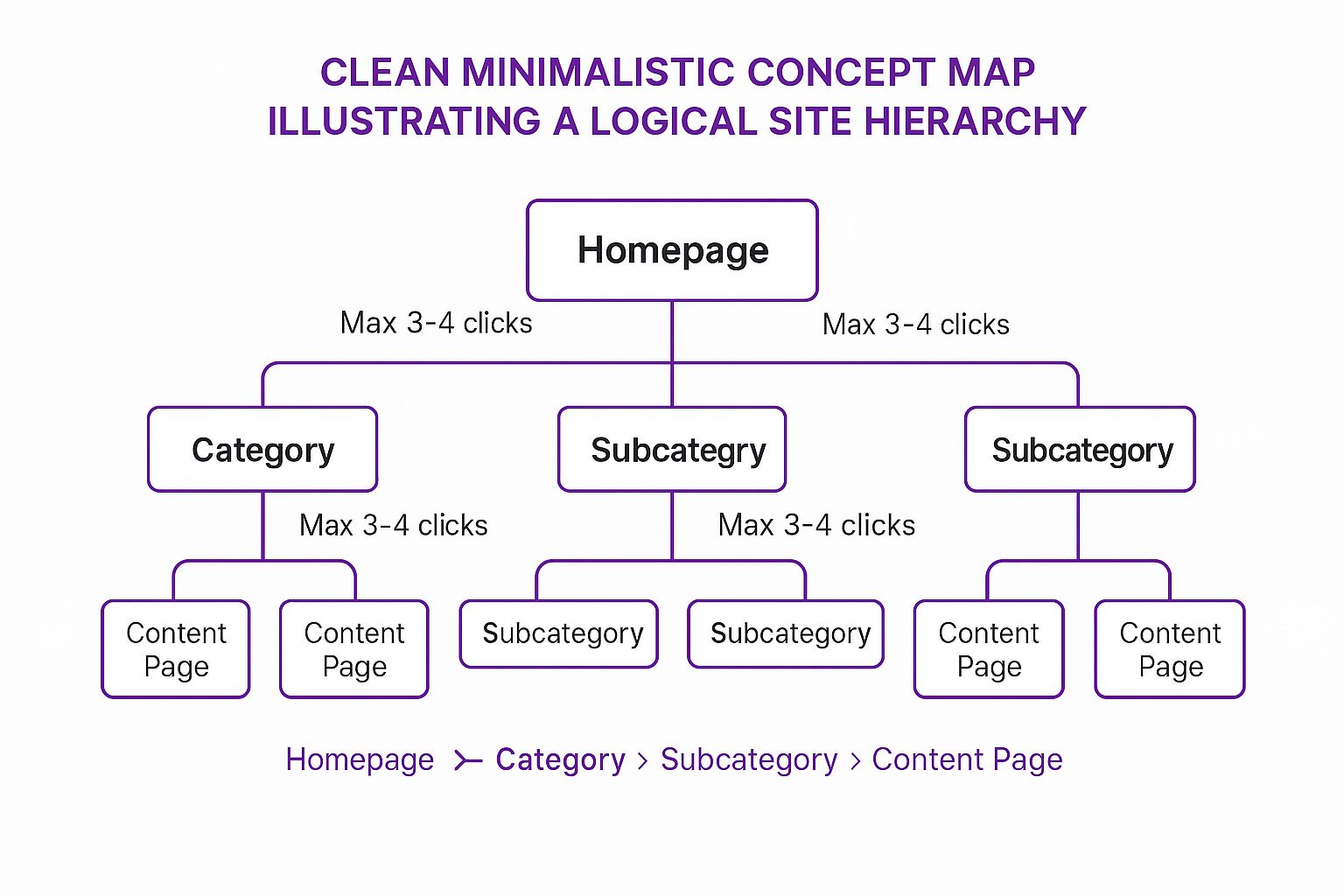
This tiered model helps distribute link equity efficiently from your most authoritative pages (like the homepage) down to more specific content. By reinforcing this structure with your internal links, you make it incredibly easy for search engine crawlers to discover, index, and understand the relationships between your pages, which is a core component of a strong SEO foundation.
How to Implement a Logical Site Hierarchy
Successful implementation starts with careful planning before you even build the links. E-commerce giant Amazon excels at this, guiding users from its homepage to broad departments (e.g., 'Electronics'), then to subcategories ('Headphones'), and finally to specific product pages. This creates an intuitive user journey that is mirrored by its internal linking. You should aim to link downwards from parent pages to child pages and also upwards where relevant to reinforce these structural relationships.
Key Insight: A logical site hierarchy acts as a blueprint for your internal linking. It guides search engine crawlers through your content efficiently and signals which pages hold the most importance on a given topic.
Actionable Tips for Site Structure Optimisation
- Map It Out First: Use a visual sitemap or mind-mapping tool to plan your site's structure before you begin creating content or links.
- Maintain a Shallow Depth: Aim to keep your most important pages within three clicks of the homepage to ensure they are easily discovered.
- Use Breadcrumb Navigation: Implement breadcrumbs on your pages to visually reinforce the hierarchy and improve user navigation.
- Regularly Audit Your Structure: As your site grows, periodically review its organisation to ensure new content fits logically within the existing framework. A clean structure is a key part of the wider discipline of what is technical SEO on bare-digital.com.
- Create a sitemap.xml: Ensure your XML sitemap accurately reflects your site's organised hierarchy and submit it to search engines.
3. Implement Hub-and-Spoke (Pillar-Cluster) Model
One of the most powerful internal linking best practices is to organise your content using the hub-and-spoke model, often called the pillar-cluster strategy. This approach structures your content around a central, comprehensive "pillar" page covering a broad topic. This pillar then links out to multiple "cluster" pages, each exploring a specific subtopic in greater detail. Crucially, every cluster page links back to the main pillar, creating a powerful, interconnected content ecosystem.

This model signals immense topical authority to search engines like Google. By grouping related content, you demonstrate a deep expertise on the subject, making it easier for your site to rank for competitive, high-volume keywords. For users, it provides a well-organised and comprehensive learning path, encouraging them to stay on your site longer.
How to Implement the Hub-and-Spoke Model
Successful implementation begins with strategic planning. Identify a broad topic that is central to your business and has significant search demand to serve as your pillar. Then, brainstorm or research all the specific subtopics that fall under that umbrella to create your cluster content. For example, HubSpot, which popularised the term, uses a pillar page on 'Marketing' that links out to detailed cluster articles on everything from SEO to email marketing and social media.
Key Insight: The hub-and-spoke model transforms your internal linking from a series of individual connections into a deliberate, authority-building architecture. It tells search engines that your website is a definitive resource on a particular subject.
Actionable Tips for Pillar-Cluster Organisation
- Identify Core Topics: Use keyword research to find broad subjects that can serve as pillars and related long-tail keywords for your clusters.
- Create Comprehensive Pillars: Pillar pages should be extensive and authoritative, often over 2,000 words, covering the core topic from a high level.
- Build Supporting Clusters: Aim for 8-15 in-depth cluster pages per pillar to establish strong topical coverage.
- Link Strategically: Every cluster page must link back to the main pillar page. The pillar page should also link out to every relevant cluster page.
- Update Regularly: As you publish new cluster content, always remember to update the pillar page to include a link to the new article.
4. Link to High-Value Pages Strategically
Not all pages on your website are created equal. Strategic linking involves prioritising internal links towards the pages most critical to your business goals, such as product pages, service pages, or high-converting cornerstone content. This practice funnels authority and user traffic to your most valuable assets, improving their search rankings and conversion potential.
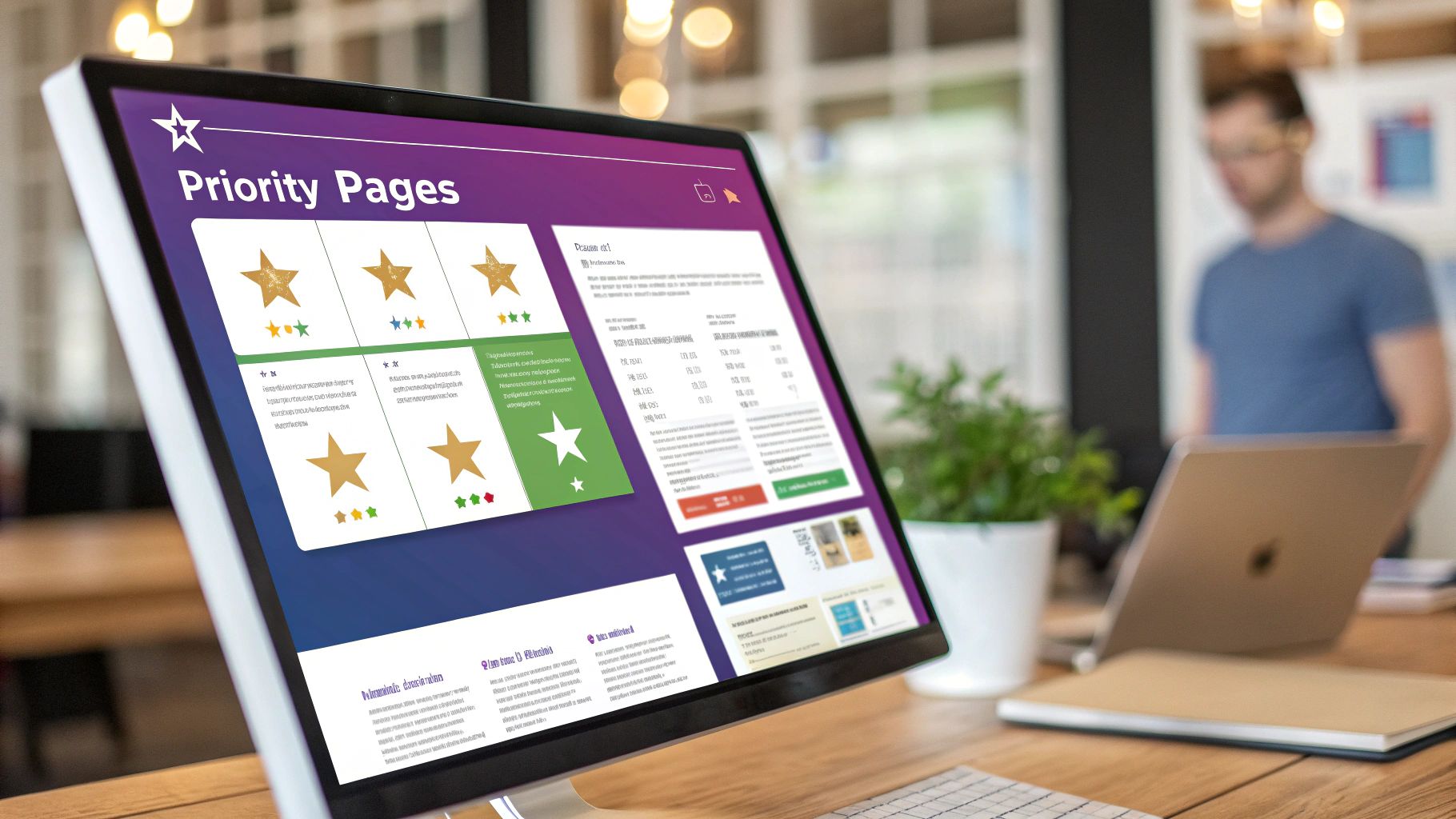
The core idea is to identify these "money pages" and systematically build links to them from other relevant content across your site. By doing so, you are signalling to search engines that these pages are significant hubs of information and value. This focused approach helps distribute link equity more effectively than a scattered, arbitrary linking plan, directly impacting your bottom line.
How to Implement Strategic High-Value Linking
Successful implementation begins with identifying which pages drive the most value. For an e-commerce site, this would be top-selling product or category pages. For a SaaS company like Monday.com, links from relevant blog posts consistently point towards their core product feature pages. This creates a logical pathway for users, guiding them from informational content towards a conversion-focused page. Similarly, a local law firm would link to their main practice area pages (e.g., "Family Law Services") from related blog articles to capture qualified leads.
Key Insight: Concentrating internal links on your highest-value pages is like watering the most fruitful plants in your garden. It ensures your most important commercial assets receive the attention they need to flourish in search results.
Actionable Tips for High-Value Page Linking
- Identify Your Pillars: Use Google Analytics conversion data and sales reports to pinpoint which pages generate the most revenue or leads. These are your targets.
- Audit for Opportunities: Review existing content, especially high-traffic blog posts, to find natural and contextually relevant places to add links to your money pages.
- Prioritise Context: Ensure every link is relevant. Forcing a link to a product page from an unrelated article harms user experience and can look manipulative to search engines.
- Create Supporting Content: Develop blog posts and articles specifically designed to support and link to your high-value pages, building a strong topical cluster. You can find more details in these internal linking strategies for SEO in 2025 on bare-digital.com.
- Monitor Performance: Regularly track the rankings, traffic, and conversion rates of your high-value pages to measure the impact of your linking efforts.
5. Maintain Optimal Internal Link Quantity
Finding the right balance in the number of internal links per page is a critical, yet often overlooked, component of internal linking best practices. The goal is to provide comprehensive navigation and distribute authority without overwhelming users or diluting link equity. Too few links can leave valuable pages undiscovered, while too many can look spammy and diminish the value passed to each link.
The key is to prioritise relevance over an arbitrary number. A well-structured page guides users to related, high-value content, enhancing their journey and signalling your site’s topical expertise to search engines. For instance, Wikipedia articles often contain a high number of links, but each one is contextually relevant and adds value, which is why the model works. In contrast, a typical blog post should be more selective to maintain clarity and focus.
How to Implement Optimal Link Quantity
Successful implementation focuses on strategic placement rather than just hitting a quota. For example, a long-form article on the Moz blog might contain 4-6 highly relevant contextual links to other posts or resources, in addition to its standard site navigation. This approach ensures that the most important pages receive link equity and users are directed to the most useful follow-up content. The aim is to make every link count.
Key Insight: The optimal number of internal links isn't a fixed rule but a guiding principle. Your focus should always be on quality and user value, ensuring each link serves a clear purpose in guiding the user and search engines.
Actionable Tips for Link Quantity Optimisation
- Follow a Guideline: As a starting point, aim for 2-5 contextual internal links per 1,000 words of content. Remember to exclude navigational links in your header and footer from this count.
- Prioritise Relevance: Never add a link just to increase the count. Each link must genuinely add value and be relevant to the context of the source page.
- Audit for Excess: Use SEO tools to identify and review pages with an excessive number of internal links. Consider removing any that are outdated or low-value.
- Avoid Over-Linking Phrases: Do not link the same anchor text multiple times on a single page. This can confuse users and offers diminishing SEO returns.
6. Fix and Optimise Orphan Pages
Orphan pages are pages on your website that have no internal links pointing to them, making them invisible to search engines and users navigating your site. Since crawlers discover content by following links, these isolated pages are often not crawled or indexed, meaning any value they hold is completely wasted. Fixing and optimising orphan pages is a crucial internal linking best practice for ensuring all your content contributes to your site’s authority.
Without incoming links, orphan pages cannot receive any "link equity" from other parts of your site, nor can they pass any on. This leaves potentially valuable content floating in a void, unable to rank or support your broader SEO strategy. Identifying and integrating these pages into your site architecture is essential for a healthy, fully-indexed website.
How to Implement Orphan Page Optimisation
The process begins with discovery. Tools like Screaming Frog or Ahrefs’ Site Audit can compare a list of crawled URLs against URLs from your sitemap to identify pages that have no incoming internal links. Once identified, each page needs to be evaluated. For example, a blog might discover old, high-quality posts that were never linked from newer articles or category pages. The solution is to weave relevant, contextual links from existing, high-traffic pages to these orphaned articles.
Key Insight: Orphan pages are dead ends for both users and search engines. By finding them and linking to them from relevant content, you are reclaiming lost assets and strengthening your site’s overall topical authority.
Actionable Tips for Fixing Orphan Pages
- Conduct a Link Audit: Use an SEO tool to crawl your site and compare the results with your sitemap or Google Analytics data to find URLs with zero internal links.
- Evaluate Each Page: For every orphan page, decide its fate. If the content is valuable, find a way to link to it. If it is outdated or irrelevant, consider deleting it and setting up a 301 redirect to a similar page.
- Build Contextual Links: Find topically relevant pages on your site and add a natural, descriptive anchor text link to the orphan page.
- Update Navigational Elements: If an orphan page is important enough (like a key service page), add it to your main navigation, footer, or relevant category pages to ensure it's easily discoverable.
7. Use Deep Linking Strategy
An effective deep linking strategy involves creating internal links that point to specific, granular pages within your site's hierarchy. Instead of funnelling all your links towards top-level pages like your homepage or main service categories, deep linking distributes authority to valuable content buried deeper within the site structure. This practice ensures these important pages receive link equity and visibility from search engines.
Deep linking helps search engine crawlers discover and index your entire site more effectively, not just the surface-level pages. By guiding both users and bots to specific, highly relevant information, you enhance the user journey and signal the depth of your expertise. For example, a user reading a blog post about digital marketing trends can be linked directly to a detailed case study on SEO, bypassing the need to navigate through a generic 'Services' page first.
How to Implement a Deep Linking Strategy
Successful implementation requires a shift in mindset from linking only to primary pages to connecting related content across all levels of your site. Wikipedia is a master of this, with almost every article containing numerous deep links to other specific entries, creating a vast, interconnected web of knowledge. Similarly, an e-commerce site might link from a blog post about "winter skincare routines" directly to a specific moisturiser product page, rather than the general "skincare" category.
Key Insight: Deep linking tells search engines that your entire website is valuable, not just the homepage. It distributes authority evenly and helps your specific, high-intent pages to rank for long-tail keywords.
Actionable Tips for Deep Linking
- Link Between Blog Posts: When writing new content, always link back to older, relevant articles. This keeps older content fresh and passes authority to it.
- Connect Related Products: On product pages, create links directly to complementary or alternative items, not just back to the main category page.
- Use Site Search Data: Analyse your internal site search queries to identify deep pages that users are actively looking for and build more internal links to them.
- Balance with Hierarchy: While deep linking is crucial, ensure your main navigation and breadcrumbs remain clear to maintain a logical site structure for users.
8. Regular Internal Link Audits and Maintenance
A website is a dynamic entity; content is added, updated, and removed over time. An internal linking strategy that was perfect six months ago might be riddled with issues today. This is why regular internal link audits and maintenance are crucial internal linking best practices. This process involves systematically reviewing your site's link structure to identify and fix problems like broken links, redirect chains, and orphaned pages, ensuring your link equity flows efficiently.
Conducting regular audits helps maintain both SEO performance and user experience. As your site evolves, an unmaintained linking structure can lead to dead ends (404 errors) and inefficient crawling for search engines. By proactively managing your internal links, you ensure that your site architecture remains robust, supporting both users and search engine bots in navigating your content effectively and distributing authority to your most important pages.
How to Implement Regular Link Audits
Successful implementation requires a scheduled, methodical approach. For example, large e-commerce sites often use automated monitoring to instantly flag broken links on product pages, preventing lost sales. Similarly, SaaS companies typically conduct a full internal link audit after launching a new feature to ensure it is properly integrated into the existing site structure. A consistent schedule prevents small issues from compounding into major SEO problems.
Key Insight: Treat your internal linking structure like a garden. It requires regular weeding and maintenance to flourish. Neglecting it allows problems like broken links and orphaned pages to grow, choking your site's SEO potential.
Actionable Tips for Link Audits and Maintenance
- Schedule Audits Regularly: Plan to conduct a full audit at least quarterly. For larger, more dynamic websites, monthly audits are preferable.
- Use Automated Tools: Leverage tools like Screaming Frog or Ahrefs' Site Audit to crawl your site and quickly identify technical issues like 404s and redirect chains.
- Prioritise Fixes: Start by fixing broken links (404s) as they have the most immediate negative impact on user experience and SEO.
- Document and Review: Maintain a document outlining your linking strategy. To ensure your internal linking strategy remains effective and identifies any issues, consider following a comprehensive ecommerce SEO audit blueprint regularly. This creates a standard to measure against.
- Monitor Post-Update: Always perform a link audit after major site updates, content migrations, or redesigns. You can explore a technical SEO audit checklist to ensure all critical elements are covered.
Internal Linking Best Practices Comparison
| Strategy | Implementation Complexity | Resource Requirements | Expected Outcomes | Ideal Use Cases | Key Advantages |
|---|---|---|---|---|---|
| Use Descriptive Anchor Text | Moderate (needs content knowledge) | Content expertise, time for audits | Improved SEO relevance and UX; higher CTR | Content-rich sites needing clear navigation | Enhances SEO signals; improves accessibility |
| Create a Logical Site Hierarchy | High (planning and restructuring) | Planning tools, ongoing audits | Better crawl efficiency; clear navigation | Large sites with diverse content | Improves user findability and site maintenance |
| Implement Hub-and-Spoke Model | High (content creation & structure) | Substantial content development | Topical authority; improved rankings | Sites focused on topic authority | Comprehensive content coverage; clear strategy |
| Link to High-Value Pages Strategically | Moderate (analysis & linking) | Analytics tools; ongoing monitoring | Higher rankings and conversions on priority pages | Business-focused sites prioritising conversions | Supports business goals; efficient authority distribution |
| Maintain Optimal Internal Link Quantity | Moderate (balancing links) | Content audits, discipline | Avoids dilution; better UX and crawlability | Sites with varying content lengths | Maintains natural linking; improves readability |
| Fix and Optimise Orphan Pages | Moderate to High (identification & fixing) | SEO audit tools; content updates | Improved indexation; recovers lost value | Sites with large or ageing content | Enhances crawlability; uncovers opportunities |
| Use Deep Linking Strategy | Moderate (strategic planning) | User behaviour data, audit tools | Better indexation of deep content; enhanced UX | Sites with deep content hierarchies | Distributes authority evenly; improves access |
| Regular Internal Link Audits and Maintenance | High (ongoing and systematic) | Specialised SEO tools; dedicated time | Maintains link quality; identifies issues early | All sites, especially large ones | Prevents link decay; aligns linking with goals |
Turn Your Linking Strategy into a Competitive Advantage
Mastering the art and science of internal linking is not a one-time project; it’s an ongoing strategic endeavour that separates good websites from great ones. Throughout this guide, we've explored the fundamental pillars of a successful strategy, moving beyond generic advice to provide actionable insights you can implement today. By consistently applying these internal linking best practices, you transform your website from a simple collection of pages into a cohesive, interconnected authority within your niche.
We've covered the critical importance of using descriptive, keyword-rich anchor text to provide context for both users and search engines. We also delved into creating a logical site hierarchy and implementing the powerful hub-and-spoke model, which organises your content around core topics and establishes topical authority. This organised structure is the bedrock of a user-friendly and SEO-friendly website, making information easier to find and demonstrating your expertise to Google.
Key Takeaways for Sustainable Growth
To truly harness the power of your internal links, remember these crucial takeaways:
- Strategic Prioritisation is Key: Not all pages are created equal. Focus your efforts on funnelling link equity towards your most valuable, high-conversion pages to directly impact your business goals.
- Maintenance is Non-Negotiable: The digital landscape is always changing. Regularly auditing your links, fixing broken ones, and finding and optimising orphan pages are essential maintenance tasks that protect your SEO performance and user experience.
- Balance is Everything: While it's vital to link generously, avoid overwhelming users. Maintain an optimal quantity of relevant, valuable internal links on each page to enhance, not detract from, the user journey.
Ultimately, a well-executed internal linking strategy does more than just tick an SEO box. It creates a seamless user experience, keeps visitors engaged on your site for longer, and distributes "link juice" effectively to boost the ranking potential of your entire domain. It provides clear, logical pathways for search engine crawlers, ensuring your most important content is discovered and indexed efficiently. The process requires diligence, but the rewards are substantial and long-lasting, building a solid foundation for sustainable growth.
Feeling overwhelmed by the technical details? If you're a business in Cambridgeshire or beyond and need expert help to implement a robust SEO and internal linking strategy, Bare Digital can help. We specialise in turning complex SEO tasks into tangible results, ensuring your site's structure is perfectly organised for both users and search engines. Contact us today to see how we can build a competitive advantage for your brand.

